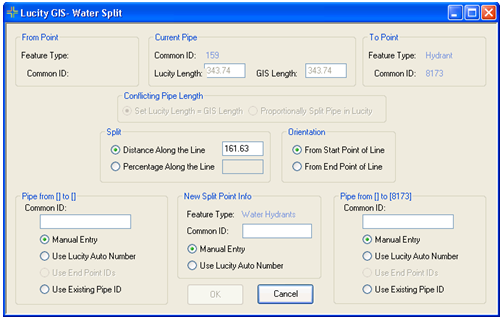![]() The Lucity GIS Edit tools includes a tool for splitting water pipes in the geodatabase and in the desktop.
The Lucity GIS Edit tools includes a tool for splitting water pipes in the geodatabase and in the desktop.
Note: This tool is only enabled if all of the following conditions are met: (1) One feature is selected in the map (2) The feature selected is linear.
How To
Split water pipes in the map





From Point: This is read only information about the from point of the existing water line.Current Pipe: This is read only information about the current pipe ID, and lengths.To Point: This is read only information about the to point of the existing water line.Conflicting Pipe Length: If the tool finds a conflicting pipe length (i.e. the Lucity Length is different from the GIS Length), users can set the length in the desktop to the length found in the map, or proportionally split the pipe in the desktop. If the Lucity Length and GIS Length are the same, the conflicting pipe length section will be disabled.Split: Indicate either the distance or percentage along the line where you'd like the split to occur. By default, the tool will identify the distance along the line based on the point that was clicked in the map. The Split section will be disabled if an existing feature was found within the edit snap tolerance. In that instance, the split distance will be pre-determined.Orientation: Choose whether the split distance or percentage is calculated from the start or end point of the line. The Orientation section will be disabled if an existing feature was found.Pipe from [] to []: These two sections are used to indicate the common IDs for the two new pipe records. Users can manually enter a new pipe ID number for each pipe, use existing pipe IDs, use auto-numbering if this feature class is configured correctly, or use endpoint ids.New Split Point Info: Fill out the common ID for the new feature inserted at the split point. Users can manually enter an ID, use the Lucity auto-number if this feature class is set up for auto-numbering. The New Split Point section will be disabled if an existing feature was found within the edit snap tolerance. In that instance, the common ID will be pre-defined.
Note: If you renumber both new pipe sections (i.e. if you don't retain the original pipe number), the original pipe will be assigned the pipe ID of the longer of the two new pipe sections. Any water associations, work orders, requests, and PMs associated with the original pipe will be associated with the new pipe record; however, they will retain the original pipe ID. Both pipe sections will be associated to existing work orders and PMs.